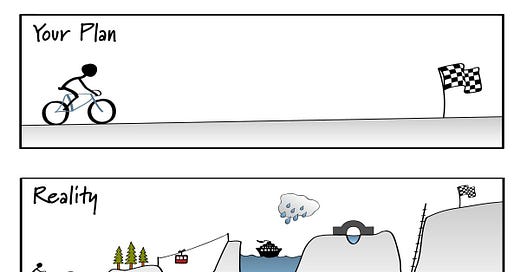The First 90 Days Every Project Manager Must Win
How to avoid buyout mistakes and keep your project on track.
👋 Hey, Kyle here! Welcome to The Influential Project Manager, a weekly newsletter covering the essentials of successful project leadership.
Today’s Overview:
The clock is ticking. The moment you receive the Notice to Proceed, risk shifts to you. The schedule feels tighter, expectations pile up, and buyout must happen at lightning speed.
Projects don’t go wrong. They start wrong. Rushing through buyout leads to scope gaps, change orders, and avoidable delays—costing time, money, and credibility. The way you handle the first 90 days determines everything.
This article gives you a blueprint. A proven buyout strategy to eliminate scope gaps, prevent chaos, and set trade partners up for success—so you can lead a predictable, high-performing project.
🏗️ Today’s issue is brought to you by Roger Scopes!
Catching every item that could lead to a scope gap.
Roger is a team of A.I. and construction experts that write best-in-class, high-detail scopes of work for commercial projects. Roger exists to accelerate schedules, cut scope gaps, and give PMs/estimators hundreds of hours back. Speed is key – usually Roger writes all its scopes in a under a week.
No new, complex software to learn – just work handled.
💸 The First 90 Days Every Project Manager Must Win
Filed under: Project Management
It finally arrives—a simple email with "Notice to Proceed" in the subject line.
After months of negotiations and planning, your project is officially live. The schedule that once seemed reasonable now feels impossibly tight. The clock is ticking.
Your phone starts buzzing—trade partners want mobilization details, the owner expects a submittal log and immediate progress, and you're staring at a mountain of contract documents that need to be translated into executable scopes.
Welcome to buyout season—the moment of truth for every project manager.
After managing dozens complex buyouts, I’ve seen teams treat this process as an administrative hurdle—a box to check before "real construction" begins. This is a costly mistake.
Buyout isn’t just about finalizing contracts; it’s the foundation for the entire project. Done right, it eliminates scope gaps, prevents change orders, and sets trade partners up for success. Done poorly, it guarantees delays, cost overruns, and strained relationships.
This article breaks down the buyout process, outlining proven strategies to prevent mistakes and create the conditions for a smooth, predictable project.
What is Buyout?
In case you’re wondering what buyout is, it involves hiring trade partners to execute specific tasks. It’s more than procurement—it’s about securing the right teams to bring labor, tools, equipment, and expertise to each work package.
These partners are then responsible for purchasing materials, completing submittals, and ensuring the right information is available for fabrication and delivery.
If buyout is rushed or incomplete, you’re setting up your project for failure before it even starts.
The Hidden Costs of Poor Buyout
Bent Flyvbjerg famously said: “Projects don’t go wrong. They start wrong.”
Poor buyout manifests in two critical ways: scope gaps and scope creep. Both are project killers, but they attack differently.
1. Scope Gap: Who’s Responsible for What?
A scope gap occurs when work is missing from the project scope or when there’s ambiguity about who is responsible for a task.
Here are real-world examples:
Electrical Work Assumptions – A guard shack at a small airport needed power. The electrical team assumed the sitework team would install conduit, while the sitework team assumed the electrical contractor would. Nobody did—until it became a $25,000 problem.
Humidity-Resistant Paint in a Swimming Pool – While building a YMCA swimming facility, the GC realized standard paint wouldn’t hold up in the humid environment. The painting subcontractor didn’t offer mold-resistant coatings, requiring an additional contractor to be brought in early to avoid delays.
Scaffolding for Exterior Work – The masonry contractor assumed the GC would provide scaffolding. The GC didn’t see it on the drawings and assumed it was included in the masonry bid. Neither planned for it—resulting in costly delays.
Even smaller gaps can cause major disruptions:
HVAC Electrical Connection – Who provides final power to the misc. HVAC equipment: the HVAC contractor or the electrician?
Caulking at Finishes – Who handles caulking at door frames, floors, and finishes: the flooring, painting, or wall protection contractor?
Firewall Penetrations – When HVAC, plumbing, or electrical pass through a firewall, who installs fire caulking: the contractor making the penetration or the fire suppression team?
Fireproofing on Structural Steel – Fireproofing steel beams is a code requirement, but who installs it? Does the structural steel contractor include fireproofing, or is it a separate trade?
Equipment Installation – In a healthcare project, who connects medical equipment to utilities: the equipment supplier or the MEP trades?
Automatic Doors & Security Integration – Who runs power to the operator: electrical or doors? Who installs low-voltage wiring for electrified hardware? Who connects it to the security panel in IT closet—the security contractor or IT?
Demolition & Wall Patching – The drawings specify removing existing wall protection but don’t mention repairing the damaged drywall before applying the new finish. Who is responsible for patching: the drywall contractor or the finish trade?
Underground Plumbing & Backfill – After installing sewer and water piping, who backfills the trench: the plumber or sitework contractor?
Ultimately, scope gaps arise when the contract fails to define clear roles. A well-coordinated buyout ensures every handoff is seamless and well understood.
2. Scope Creep: Uncontrolled Expansion
Scope creep happens when additional work is added outside of the original contract without formal approval.
Examples of scope creep:
Expanding floor plans mid-project – A client decides to add extra storage rooms, affecting structure, MEP, and finishes.
Material upgrades after procurement – The owner initially approved standard tile but later requested custom marble, delaying progress.
Redesigning structural elements – A developer adds decorative steel beams late in construction, requiring additional engineering and material procurement.
Complex landscaping features added late – Originally planned for basic landscaping, but the client later requests elaborate water features and lighting.or redesigns, adding structural changes and delaying foundation work.
Scope creep is almost always preventable with strong contracts, clear communication, and a disciplined change order process.
⏰ The First 90 Days: How to Master Buyout
Through trial, error, and costly lessons, I’ve built a buyout strategy that consistently delivers. Here are the core elements:
1. Pre-Buyout Planning
Success starts with thorough pre-buyout planning.
Complete your budget—ensure it’s vetted and accurate.
Prepare excellent bid packages—include budget, schedule, logistics, project info, scope, general inclusions, contract docs, plans, and specs.
This preparation is essential for attracting top-notch trade partners.
2. The 48-Hour Reset
When NTP arrives, resist the urge to jump straight into execution. Take a strategic pause to reassess:
Review all contract documents with fresh eyes:
Specifications
Prime Contract
Contract Drawings
Conditions of Satisfaction
Map out critical scope interfaces—who owns what?
Identify high-risk trade packages—where are the gaps?
Create a buyout schedule—prioritize critical scopes first.
Align internal team responsibilities—who’s handling what?
Taking the time to fully understand a project — including asking any questions needed to clarify its requirements — plays a huge role in mitigating scope gaps and scope creep.
3. Scope Architecture: Writing with Precision
A poorly written scope leads to missed work and change orders. Follow a structured hierarchy:
Level 1: Overall project requirements
Level 2: Major systems and areas
Level 3: Individual trade contractor scopes
Level 4: Coordination & interface details
Level 5: Culture, behaviors, and accountability.
Writing scopes is an art—too vague, and you get ambiguity. Too detailed, and you create bottlenecks.
❌ Too broad: "Install all plumbing piping per specs and plans."
❌ Too detailed: "Install 100 L.F. of CW piping per P100."
✅ Just right: "Install CW piping where it occurs, including ¾”, 1”, and 2” piping per P100."
The goal? Clarity. Not too vague, not too prescriptive.
4. The Three-Pass Review Method: Catch Issues Before They Catch You
Every scope should be reviewed through three distinct lenses:
🔍 Technical Review:
Are quality standards clearly defined?
Have engineering requirements been captured?
Are testing and inspection requirements outlined?
💰 Commercial Review:
Are contract terms aligned with the Prime?
Are assumptions and exclusions documented?
Is the pricing structure appropriate?
🔄 Integration Review:
How does this scope interact with others?
Are coordination responsibilities clear?
Have all hand-off points been defined?
A disciplined review process prevents gaps, conflicts, and costly surprises.
5. Setting the Stage for Success: Buying More Than Just the Work
Buyout isn’t just about contracts—it’s about expectations. If you don’t purchase the behaviors you expect, don’t be surprised when you don’t get them.
Quality standards—define expectations upfront.
Coordination responsibilities—who owns what?
Production rates—set clear output targets.
Safety & engagement requirements—align all parties.
Lean Construction practices—implement lean the right way.
Communication & change management—prevent misalignment.
You’re not just buying labor—you’re setting the conditions for how the job will be built.
6. Technology as a Force Multiplier: Eliminate Scope Gaps Before They Happen
AI is transforming buyout. Instead of manually combing through drawings, you can now catch gaps instantly.
Roger Scopes uses a combination of AI, software, and construction expertise to deliver complete scopes of work—fast.
Step 1: Send Roger your drawings.
Step 2: Short kickoff meeting with the team.
Step 3: Receive a complete list of contract items.
Step 4: Assign items and generate scope sheets—all in one portal.
Roger eliminates scope gaps, accelerates buyout, and frees up PMs from one of their most mind-numbing tasks.
📅 Want to see it action? Schedule a demo here.
7. Conduct a Kickoff Meeting: Lock In Expectations
Once trade partners are on board, hold a structured kickoff meeting covering:
Pre-mobilization requirements—submittals, safety, quality plans.
Schedule alignment—set realistic expectations.
Roles & responsibilities—define who owns what.
Change order protocol—prevent disputes later.
Throughout the project, monitor trade partners to ensure they adhere to scope inclusions and exclusions. Continuously provide feedback to improve future projects.
The Path to Predictable Outcomes
Unfortunately, the pressure to execute buyout quickly isn’t going away. But rushing guarantees problems later—while a disciplined approach ensures:
Safe jobsites
Controlled costs
High-quality work
Predictable schedules
Stronger trade partnerships
And most importantly—a project you can lead with confidence.
The clock starts ticking the moment NTP arrives. How you spend those first 90 days determines everything.
Until next week,
Kyle Nitchen

Whenever you're ready, there are 5 ways I can help you:
Get my first book! No Bullsh*t Project: A Project Manager’s Guide to Successful Project Leadership
Upgrade your scheduling software. Experience the future planning system for construction and real estate development. iPM subscribers get a 15% discount on the first year license.
Get my full toolbox (free). Access 30+ software and hardware tools I'm using today.
Learn Takt Planning. Elevate your skills as a scheduler, planner, and lean builder with the Takt Planning & Control online course. Use code "Influentialpmtakt" for 30% off.
Advertise in my newsletter. Put your brand in front of 5,800+ construction project managers, leaders, and execs. (Booked out 8 weeks)






